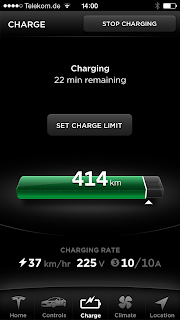Usually solar powered cars are some goofy looking vehicles taped together by a few undergrad students for a solar mobility competition in the Australian outback. That's all very good and important, but in my view there is much more to the concept. Electricity can efficiently and cleanly be produced by photovoltaics and electric vehicles of all kinds can be efficiently powered by it. Let's look at both of these aspects.
PV arrays have increased in efficiency while dropping sharply in price. In 1980, a MWh of solar power would have cost almost $1,600 while in 2010 the same amount of power was available for $200 (as outlined in the much recommend GMO quarterly report by Jeremy Grantham). Prices are likely to continue to go down making solar a highly competitive power source. If only it were to shine all 24 hours of each day...
Similarly, electric vehicles are much more efficient in use of primary energy to move about their cargo (i.e. single humans mostly). Even if we were to burn the same gasoline in a stationary large scale facility to generate electricity, it would be more efficient than driving around a small scale engine with direct exhausts. More so, electric vehicles have much less moving parts and are simply more economical over time (on top of being more ecological right out of the gate). A quick look at key ingredients of the Tesla Model S makes that point clear.
In my personal quest to become electricity (not quite energy) independent, I have added a PV array to our house capable of producing 27 kWp (that's kilowatt peak). Even in "sunny" Germany, this setup produces about 24,000 kWh / year, which I can consume or sell back into the grid as clean energy due to the German system of feed-in tariffs. This, of course, is way more electricity than we consume as a family (about 6,000 kWh per year for a 6 person household). But this is where electric mobility comes in. We can use the excess power we generate to charge our electric car! On a clear sunny day this looks as follows:
Our solar power control center "SMA home manager" shows the current electricity flow from the roof to the house drawing 7.4 kW (and taking 260 W from the grid to supplement).
At the same time, the car is set from my iPhone's mobile app to being charging at this moment consuming the locally generated clean solar power to fill its battery. That's what I call a "solar powered car".
An electric vehicle has a certain amount of kWh it consumes per 100km driven. The new BMW i3 for example is rated at 12.9 kWh / 100km. So to drive 20.000 km it would require 2.580 kWh. This is an amount that can be achieved by a normal household sized roof top PV array. Even if sourced from the grid as 100% renewable energy at .25 Euro-Cents / kWh, it would be less than half of what you would have to pay at the pump to drive that far.
The crux is that our car is not always parked in our home garage plugged into our house grid when the sun shines. This is where two co-dependent factors come into play: a high number of electric vehicles and wide distribution of standardized charge points. As soon as EVs can be plugged in (or better using plugless charging systems) at work, at the supermarket, at the gym, almost anywhere, they can be connected to the grid as an electricity consumer while charging as well as contributor selling electricity back. The accounting for the demand and supply based battery management is likely easier than my daughters cell phone plan. On a large scale many of these 'driving storage systems' can be used to manage the inherent ebb and flow of renewable energy sources in today's electricity grids.
In my view, a future with de-centrally produced clean energy, a large number of electric vehicles and a widespread bi-directional charging infrastructure is possible. It is the true potential of solar powered cars and a much preferable outlook over today's fossil fuel based mobility.




No comments:
Post a Comment